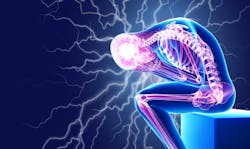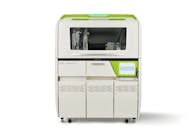To take the test online go HERE. For more information, visit the Continuing Education tab.
LEARNING OBJECTIVES
Upon completion of this article, the reader will be able to:
1. Differentiate between the three different types of inflammation.
2. Describe the immune process in which inflammation plays a role in.
3. Discuss the chronic inflammatory process and its role in certain conditions.
4. List and discuss the laboratory tests that are useful in detecting and monitoring inflammation in certain diagnoses.
Inflammation is part of the body’s innate defense mechanism that is triggered when tissues are injured (such as from trauma or heat) or infected by microbes or viruses. Inflammation is characterized by heat, redness, swelling, pain, and loss of function at the affected site.1 Inflammation can be of three types:
Acute: Occurs immediately after injury and usually resolves in a few days
Chronic: May last for months or even years when acute inflammation fails to settle
Sub-acute: A transformational period from acute to chronic which lasts from two to six weeks2
The inflammatory pathway consists of a sequence of events involving inducers, sensors, mediators, and effectors. The process is initiated in the presence of inducers, which can be infectious organisms or noninfectious stimuli such as foreign bodies and signals from necrotic cells or damaged tissues. This activates the sensors, which are specialized molecules. The sensors then stimulate the inflammatory mediators including cytokines, histamine, bradykinin, prostaglandins, and leukotrienes, which are endogenous chemicals that cause blood vessels to leak fluid into the tissues, causing swelling. This event promotes the migration of neutrophils and macrophages to the area of acute inflammation.3 The inflammatory mediators can induce pain, activate or inhibit inflammation and tissue repair, and can activate the effectors, which are the tissues and cells. Other mediators act as regulatory components to establish homeostasis after injury or prevent the inflammatory process.4 These players can act together and give rise to multiple alternative pathways in the inflammatory process, depending on the type of stimuli.
The goal of the inflammatory process is to restore homeostasis regardless of the cause. If this inflammation does not resolve within six weeks, this will cause the acute inflammation to develop from subacute to chronic form of inflammation with the migration of T lymphocytes and plasma cells to the site of inflammation. If this persists with no recovery, then tissue damage and fibrosis will ensue. Other varieties of cells, such as macrophages and monocytes, play a role in both acute and chronic inflammation.1
Chronic inflammation6 is a slow, long-term inflammation lasting several months to years. The extent and effects of chronic inflammation vary with the cause of the injury and the ability of the body to repair and overcome the damage. Chronic inflammation may happen due to:6
- Failure to eliminate the acute inflammation causative agent such as infectious organisms including Mycobacterium tuberculosis, protozoa, fungi, and other parasites as they are able to resist host defenses and remain in the tissue for an extended period.
- Exposure to a low level of a particular irritant or foreign material that cannot be eliminated by enzymatic breakdown or phagocytosis in the body including substances or industrial chemicals that can be inhaled over a long period, for example, silica dust.
- An autoimmune disorder in which the immune system identifies the normal component of the body as a foreign antigen, and attacks healthy tissue giving rise to diseases such as rheumatoid arthritis (RA) and systemic lupus erythematosus (SLE).
- A defect in the cells responsible for mediating inflammation leading to persistent or recurrent inflammation, such as auto-inflammatory disorders (familial Mediterranean fever).
- Recurrent episodes of acute inflammation. However, in some cases, chronic inflammation is an independent response and not a sequel to acute inflammation, for example diseases such as tuberculosis and rheumatoid arthritis.
- Inflammatory and biochemical inducers causing oxidative stress and mitochondrial dysfunction such as increased production of free radical molecules, advanced glycation end products (AGEs), uric acid (urate) crystals, oxidized lipoproteins, homocysteine, and others.
More than 50% of all deaths are attributed to diseases related to systemic chronic inflammation (SCI) such as ischemic heart disease, stroke, cancer, diabetes mellitus, chronic kidney disease, non-alcoholic fatty liver disease (NAFLD), and autoimmune and neurodegenerative conditions.7
Shifts in the inflammatory response from short- to long-lived can cause a breakdown of immune tolerance causing major alterations in all tissues and organs, as well as normal cellular physiology, which can increase the risk for various non-communicable diseases in both young and older individuals. SCI can also impair normal immune function, leading to increased susceptibility to infections and tumors and a poor response to vaccines. Furthermore, SCI during pregnancy and childhood can have serious developmental consequences such as elevating the risk of non-communicable diseases over an individual’s life span.8
Tests to detect inflammation
As certain proteins are released into the bloodstream during inflammation and when their concentrations increase or decrease by at least 25%, they can be used as biomarkers to detect systemic inflammation. Although there are many inflammatory markers, also known as acute phase reactants, those most commonly measured in clinical practice are C-reactive protein (CRP), erythrocyte sedimentation rate (ESR), plasma viscosity (PV) and procalcitonin (PCT).9,10 These markers are not specific for a particular condition and hence cannot be used for differential diagnosis but they help to identify a generalized inflammatory state. Other tests need to be used along with these tests for differential diagnosis. Because these markers are nonspecific, the tests are not diagnostic for any particular condition, but they may help to identify a generalized inflammatory state along with other tests and aid in the differential diagnosis.
In some diseases, serial measurements of CRP also may be of prognostic value.11 PCT is a newer marker of inflammation that may in certain cases identify or exclude bacterial infections and guide antibacterial treatments.12,13
Besides CRP, ESR, and PCT, some other markers of inflammation include serum amyloid A, cytokines, alpha-1-acid glycoprotein, plasma viscosity, ceruloplasmin, hepcidin, and haptoglobin. However, high cost, limited availability, and lack of standardization may limit practical clinical use of markers other than CRP, ESR, and PCT in the evaluation of inflammation. Yet some acute phase proteins, for example, alpha-1 antitrypsin, fibrinogen and coagulation factors, and complement factors, serve a role in specific diagnoses.9
C-reactive protein (CRP) test: CRP is an acute-phase reactant protein synthesized by the liver; and the level rises in response to inflammation. CRP has both pro-inflammatory and anti-inflammatory properties,14 and it plays a role in the recognition and clearance of foreign pathogens and damaged cells. It can activate the classic complement pathway and also activate phagocytic cells to expedite the removal of cellular debris and damaged or apoptotic cells and foreign pathogens. This can become pathologic, however, when it is activated by autoantibodies displaying the phosphocholine arm in autoimmune processes, such as idiopathic thrombocytopenic purpura (ITP). It can also worsen tissue damage in certain cases by activation of the complement system and thus inflammatory cytokines.15, 16, 17
The levels of CRP rise and fall rapidly with the onset and removal of the inflammatory stimulus.14 Persistently elevated CRP levels can be seen in chronic inflammatory conditions such as chronic infections or inflammatory arthritides such as rheumatoid arthritis. Elevated CRP can be due to acute and chronic conditions, which can be of infectious or non-infectious etiology. However, markedly elevated levels of CRP are most often associated with an infectious cause.18 Trauma can also cause elevations in CRP. More modest elevations tend to be associated with a broader spectrum of etiologies, ranging from sleep disturbances to periodontal disease.14
CRP has a narrow range of normal values, usually <3-10 mg/L in the blood, but in patients with infections or inflammatory conditions, levels can rise several hundred-fold.19, 20 CRP is also a useful measure because concentrations change rapidly within the first 6–8 hours after injury, peak after 48 hours, and return to normal levels once the issue has resolved.20 Some studies indicate that high serial CRP measurements in hospitalized patients may be associated with poor outcomes in those who are critically ill.11
High-sensitivity CRP test: High-sensitivity CRP is a much more sensitive form of the standard CRP test. Small increases in the baseline levels of CRP, typically between 1 and 3 mg/L, that are only detectable with a high sensitivity CRP test are early signs of certain diseases, especially cardiovascular conditions including atherosclerosis and neurological degeneration.21,22 Elevated high-sensitivity CRP results are frequently observed prior to cases of myocardial infarction, stroke, peripheral arterial disease, and sudden cardiac death in otherwise healthy people.23,24 They are also indicative of recurring incidents and death in patients with acute or stable coronary conditions across most other measures of coronary health (e.g., LDL cholesterol, blood pressure, etc.).23
Methods of CRP/hs-CRP determination: With time, the techniques used to detect CRP have evolved.25 Earlier, CRP was detected based on antigen–antibody interaction using precipitation and agglutination reactions. Later on, CRP enzymatic assays (ELISA) came into existence, which were further modified by integration of an antigen-antibody detection system with surface plasma spectroscopy. Then followed electrochemical biosensors where nanomaterials were used to make a highly sensitive and portable detection system based on silicon nanowire, metal-oxide-semiconductor field-effect transistor/bipolar junction transistor, ZnS nanoparticle, aptamer, field emission transmitter, vertical flow immunoassay, etc.25
Interpretation of CRP levels:
< 0.3 mg/dL: Normal (level seen in most healthy adults).
0.3 - 1.0 mg/dL: Normal or minor elevation (can be seen in obesity, pregnancy, depression, diabetes, common cold, gingivitis, periodontitis, sedentary lifestyle, cigarette smoking, and genetic polymorphisms).
1.0 - 10.0 mg/dL: Moderate elevation (systemic inflammation such as RA, SLE, or other autoimmune diseases, malignancies, myocardial infarction, pancreatitis, bronchitis).
>10.0 mg/dL: Marked elevation (acute bacterial infections, viral infections, systemic vasculitis, and major trauma).
>50.0 mg/dL: Severe elevation (acute bacterial infections).14
Interfering factors: Certain factors have been found to interfere with CRP results.14 These include certain medications, such as non-steroidal anti-inflammatory drugs (NSAIDs), statins, and magnesium supplements, which have been found to falsely decrease CRP levels. Recent injury or illness can falsely elevate CRP, especially when using this test for cardiac risk stratification. Similarly, mild elevations in CRP can be seen without any systemic or inflammatory disease in certain cases. And obesity, insomnia, depression, smoking, and diabetes can all contribute to mild elevations in CRP.
Erythrocyte sedimentation rate (ESR): The ESR measures the rate at which the red blood cells separate from the plasma and fall to the bottom of a test tube.9 Thus, ESR is an indirect measure of plasma protein concentrations.10 The rate is measured in millimeters per hour (mm/hr). The normal range for ESR is 0-22 mm/hr for men and 0-29 mm/hr for women.9 This is easy to measure as there will be a number of millimeters of clear liquid at the top of the red blood after one hour. If certain proteins cover red cells, these will stick to each other and cause the red cells to fall more quickly. So, a high ESR indicates that one has some inflammation, somewhere in the body.
Levels of ESR are generally higher in females. The level also increases with age.10 ESR is also influenced by a number of disease states. Because the ESR depends on several proteins with varying half-lives, the rate rises and falls more slowly than do CRP concentrations.19,26 Although CRP measurements are considered a better marker for inflammation compared to ESR values, the ESR test remains useful in the diagnosis of select conditions, particularly general bone lesions and osteomyelitis. 19,27
Plasma viscosity (PV): Plasma viscosity is measured by calculating the force needed to send plasma down a thin tube in a given time. Normal plasma viscosity is around 1.3-1.7mPas (millipascal second). The higher the result, the more viscous (or “thicker”) the blood is. Increased levels of protein in the plasma (liquid) part of the blood make the blood thicker. Plasma viscosity can be used as an indirect measure of the amount of inflammation in the body. It can also detect the presence of abnormal paraproteins, which can be produced by certain types of tumors. Increased blood levels of certain proteins, such as fibrinogen (which is increased in inflammation) or immunoglobulins (which are increased in inflammation or secreted by some tumors) cause the plasma viscosity to rise.28 However, it is more difficult to perform and hence not as widely used as ESR testing.9
Procalcitonin (PCT): PCT is a newer marker of inflammation that may in certain cases identify or exclude bacterial infections and guide antibacterial treatments.12, 13 The release of PCT into the body’s circulation is most often induced by bacterial infection; however, other causes, including severe viral infection, pancreatitis, tissue trauma, and certain autoimmune disorders can also increase PCT.12, 13 PCT elevations are not usually associated with bacterial colonization, localized bacterial infection, or allergic responses.13 Increased PCT levels have a high positive predictive value in the diagnosis of sepsis, and normal levels have a high negative predictive value.13 PCT measurements can also be used to help personalize treatment, manage antibiotic prescriptions, and reduce antibiotic exposure, which has prompted the U.S. Food and Drug Administration (FDA) to approve the use of PCT testing to guide antibiotic use in patients with acute respiratory illnesses.12
Interfering factors: Although procalcitonin assays have shown promising results over the years, there are still several limitations. For example, it has been shown that PCT serum levels can also become elevated among patients during times of noninfectious conditions, such as with trauma, burns, carcinomas (medullary C-cell, small cell lung, & bronchial carcinoid), immunomodulator therapy that increase proinflammatory cytokines, cardiogenic shock, first two days of a neonate's life, during peritoneal dialysis treatment, and in cirrhotic patients (Child-Pugh Class C). PCT levels have also falsely elevated in patients suffering from various degrees of chronic kidney disease. Thus, it is vital for the clinician to rule out the above scenarios to ensure there are no confounding issues that may be obscuring the PCT measurements.29,30
Conclusion
The currently used tests for inflammation are majorly nonspecific and hence clinicians need additional tests for diagnosis of chronic inflammations affecting different organs — heart, lungs, pancreas, liver, intestines, etc. We hope with advancements in omics technologies, more specific biomarkers will be developed that could help clinicians to easily diagnose diseases associated with inflammation.
References
1. Hannoodee S, Nasuruddin DN. Acute Inflammatory Response. StatPearls Publishing; 2022.
2. Pahwa R, Goyal A, Statpearls JI. StatPearls Publishing; Treasure Island (FL): Aug 8, 2022. Chronic Inflammation.
3. Germolec DR, Shipkowski KA, Frawley RP, Evans E. Markers of Inflammation. Methods Mol Biol. 2018;1803:57-79. doi:10.1007/978-1-4939-8549-4_5.
4. Medzhitov R. Inflammation 2010: new adventures of an old flame. Cell. 2010;19;140(6):771-6. doi:10.1016/j.cell.2010.03.006.
5. Medzhitov R. Origin and physiological roles of inflammation. Nature. 2008;24;454(7203):428-35. doi: 10.1038/nature07201.
6. Pahwa R, Goyal A, Jialal I. Chronic Inflammation. StatPearls Publishing; 2022.
7. GBD 2017 Causes of Death Collaborators. Global, regional, and national age-sex-specific mortality for 282 causes of death in 195 countries and territories, 1980-2017: a systematic analysis for the Global Burden of Disease Study 2017. Lancet. 2018;10;392(10159):1736-1788. doi:10.1016/S0140-6736(18)32203-7.
8. Furman D, Campisi J, Verdin E, et al. Chronic inflammation in the etiology of disease across the life span. Nat Med. 2019;25(12):1822-1832. doi:10.1038/s41591-019-0675-0.
9. Willacy H. Inflammation blood tests. Patient.info. Accessed May 17, 2023. https://patient.info/treatment-medication/blood-tests/blood-tests-to-detect-inflammation.
10. Inflammatory markers. Arupconsult.com. Accessed May 17, 2023. https://arupconsult.com/content/inflammatory-markers.
11. Lelubre C, Anselin S, Zouaoui Boudjeltia K, Biston P, Piagnerelli M. Interpretation of C-reactive protein concentrations in critically ill patients. Biomed Res Int. 2013;2013:124021. doi:10.1155/2013/124021.
12. Schuetz P, Beishuizen A, Broyles M, et al. Procalcitonin (PCT)-guided antibiotic stewardship: an international experts consensus on optimized clinical use. Clin Chem Lab Med. 2019;57(9):1308‐1318. doi:10.1515/cclm-2018-1181.
13. Meisner M. Update on procalcitonin measurements. Ann Lab Med. 2014;34(4):263-273. doi:10.3343/alm.2014.34.4.263.
14. Nehring SM, Goyal A, Patel BC. C Reactive Protein. StatPearls Publishing; 2022.
15. Da C, Eranki AP. StatPearls Publishing; Treasure Island (FL): Aug 8, 2022. Procalcitonin.
16. Jungen MJ, Ter Meulen BC, van Osch T, Weinstein HC, Ostelo RWJG. Inflammatory biomarkers in patients with sciatica: a systematic review. BMC Musculoskelet Disord. 2019;9;20(1):156. doi:10.1186/s12891-019-2541-0.
17. Kramer NE, Cosgrove VE, Dunlap K, Subramaniapillai M, McIntyre RS, Suppes T. A clinical model for identifying an inflammatory phenotype in mood disorders. J Psychiatr Res. 2019;113:148-158. doi:10.1016/j.jpsychires.2019.02.005.
18. Vanderschueren S, Deeren D, Knockaert DC, Bobbaers H, Bossuyt X, Peetermans W. Extremely elevated C-reactive protein. Eur J Intern Med. 2006;17(6):430-3. doi:10.1016/j.ejim.2006.02.025.
19. Gabay C, Kushner I. Acute-phase proteins and other systemic responses to inflammation. N Engl J Med. 1999;340(6):448-454. doi:10.1056/NEJM199902113400607.
20. Vitamin V. C-reactive protein concentrations as a marker of inflammation or infection for interpreting biomarkers of micronutrient status. Who.int. Accessed May 17, 2023. https://apps.who.int/iris/bitstream/handle/10665/133708/WHO_NMH_NHD_EPG_14.7_eng.pdf?.
21. Oh SW, Moon JD, Park SY, Jang HJ, Kim JH, Nahm KB, Choi EY. Evaluation of fluorescence hs-CRP immunoassay for point-of-care testing. Clin Chim Acta. 2005;356(1-2):172-7. doi:10.1016/j.cccn.2005.01.026.
22. Hergenroeder G, Redell JB, Moore AN, Dubinsky WP, et al. Identification of serum biomarkers in brain-injured adults: potential for predicting elevated intracranial pressure. J Neurotrauma. 2008;25(2):79-93. doi:10.1089/neu.2007.0386.
23. Back JL. Cardiac injury, atherosclerosis, and thrombotic disease. In: McPherson A, ed. Henry’s Clinical Diagnosis and Management by Laboratory Methods. 14th ed. Elsevier; 2022:267-275.
24. Bassuk SS, Rifai N, Ridker PM. High-sensitivity C-reactive protein: clinical importance. Curr Probl Cardiol. 2004;29(8):439-93.
25. Chandra P, Suman P, Airon H, Mukherjee M, Kumar P. Prospects and advancements in C-reactive protein detection. World J Methodol. 2014;26;4(1):1-5. doi:10.5662/wjm.v4.i1.1.
26. Bray C, Bell LN, Liang H, Haykal R, Kaiksow F, Mazza JJ, Yale SH. Erythrocyte Sedimentation Rate and C-reactive Protein Measurements and Their Relevance in Clinical Medicine. WMJ. 2016;115(6):317-21.
27. Singh G. C-reactive protein and erythrocyte sedimentation rate: Continuing role for erythrocyte sedimentation rate. Adv Biol Chem. 2014;04(01):5-9. doi:10.4236/abc.2014.41002.
28. Plasma viscosity. Org.uk. Accessed May 17, 2023. https://labtestsonline.org.uk/tests/plasma-viscosity.
29. Hatzistilianou M. Diagnostic and prognostic role of procalcitonin in infections. ScientificWorldJournal. 2010;1;10:1941-6. doi:10.1100/tsw.2010.181.
30. Grace E, Turner RM. Use of procalcitonin in patients with various degrees of chronic kidney disease including renal replacement therapy. Clin Infect Dis. 2014;15;59(12):1761-7. doi:10.1093/cid/ciu732.





